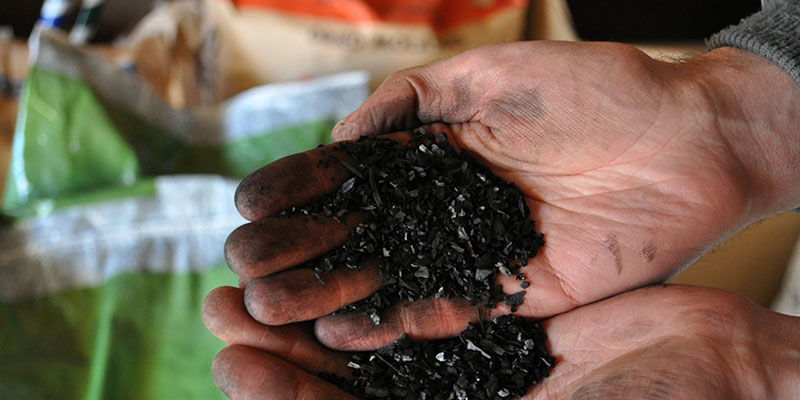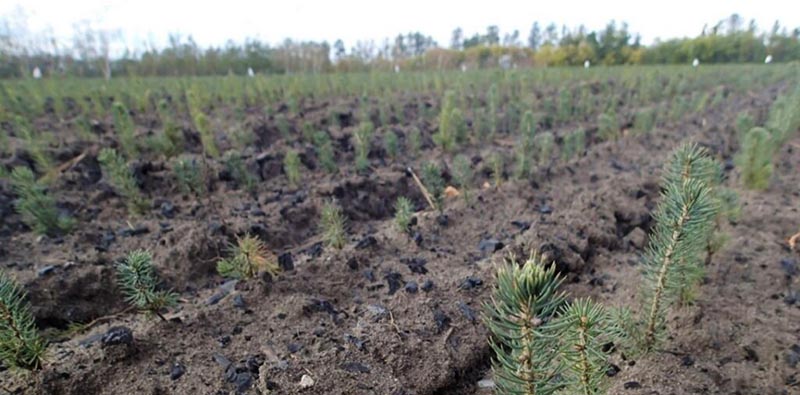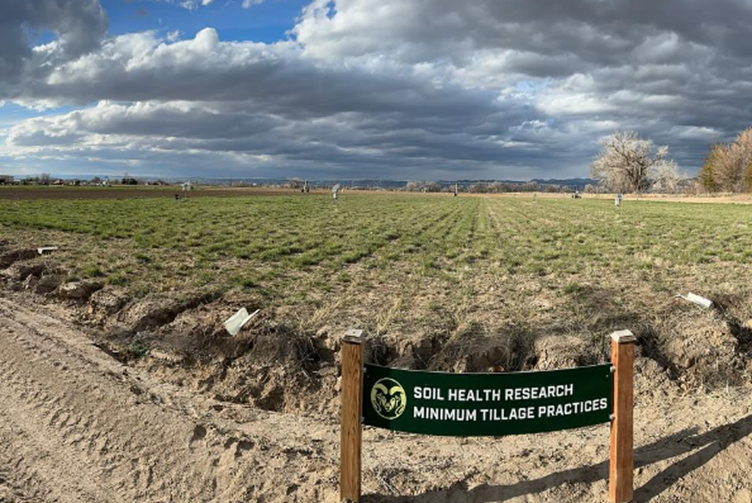
Updated by Derek Lowstuter (10/24)
Quick Facts
- Biochar has demonstrated value for a variety of applications – such as utilizing wood wastes from overcrowded or pest- infested forests, storing carbon in soils, mine remediation, and for use in crop and animal agriculture – but continued research is necessary to better inform management decisions.
- A commercial biochar market is developing in the U.S. However, it is largely confined to laboratories, experimental field sites, mine reclamation, and specialty crops.
- Biochar production can be profitable on a case-by-case basis, but success is often dependent on feedstock costs, carbon credit markets, policy incentives, and demand for biochar in industrial or agricultural applications. Sales to home and market gardeners have been a primary driver for the rapidly growing market.
Introduction
Biochar is being researched and used in a variety of applications across Colorado. Its use has the potential to provide benefits to multiple economic sectors, at multiple scales. Biochar applications may have a critical role in mitigating climate change, reclaiming and restoring land, and boosting soil health. This factsheet discusses some of the latest research relevant to biochar applications in Colorado such as:
- Providing a market for wood from forest thinnings intended to reduce fire risk and severity.
- Generating coproducts, such as bio-oil, syngas, wood vinegar, and thermal or electric power.
- Storing carbon and reducing greenhouse gas emissions
- Restoring contaminated sites, such as mines
- Aiding in water and nutrient cycling in agriculture
Biochar Production
What is Biochar?
Biochar is a carbon-rich material made by heating biomass (plant or animal material) to high temperatures (480-1800°F) in the absence of oxygen (1). This process is called pyrolysis. Pyrolysis chemically and physically alters the composition of the biomass to produce a highly porous, stable form of organic matter that can be used in various agricultural, ecological, and industrial applications. Biochar can be produced from a variety of feedstocks including forest residues, crop residues, and purpose grown biomass. Most biochar is currently produced from waste sources, such as slash from forest thinnings, because these sources are usually the most economical and provide additional benefits, such as improving forest health. The source material (feedstock) and pyrolysis conditions influence the chemical and physical properties of the biochar produced. This means that different biochars can be custom-made for different management objectives, but attention should be given to identify desirable properties.
Forest Management
If biochar can be produced on a large enough scale, it may change how forests are managed. Specifically, trees that are killed by pests, such as mountain pine beetle or western spruce budworm, may be viewed as a valuable source for manufacturing biochar rather than a wasted resource. Many of Colorado’s forests suffer from overcrowding due to wildfire suppression and widespread mortality from pest outbreaks (2). Current forest management practices involve controlled ground fires, whole tree harvesting, and burning of smaller-diameter forest fuels in slash piles.
These practices can be expensive, pose fire risks, cause smoke pollution, and can degrade the land if not properly managed. Biochar production has potential to turn pest-damaged stands, hazard trees, and other residues from fuels reduction treatments into value-added products. Rather than being burned in the forest, whole trees and residues could be harvested as a feedstock. A study of Colorado households indicated that residents were hypothetically willing to pay roughly the same for burning slash on-site and moving it off-site for biochar production as a means of reducing the intensity of future wildfires (3).
Biochar companies in Colorado primarily produce biochar from trees harvested on public land. Much of this is along the Front Range, where forests and human developments overlap, and includes trees grown in urban areas as well as in the wildland interface. By creating value for this “waste wood,” biochar production can help lower the cost of forest management practices. Studies indicate that long distances between the forest and the biochar processing centers should prompt a closer look at pre-processing or other means for reducing transportation costs associated with making biochar from insect-killed wood (4,5).
Portable systems have been developed to produce biochar much closer to where trees are harvested. Biochar is significantly less dense than the feedstock made to produce it (6). Producing biochar before leaving the forest can substantially reduce transportation costs, but additional processing may be required to prepare biochar for transportation. Portable biochar production systems range in size from small flame cap kilns to large air-curtain burners each having their advantages and disadvantages (7). The USDA-Forest Service has worked with industry partners to develop and deploy a towable biochar-producing burner called the CharBoss.
Wood waste being loaded into the CharBoss using a skid-steer.
(Image Source: USDA-Forest Service Rocky Mountain Research Station)
Liquid and Gas Co-products
Biochar producers can adjust pyrolysis conditions to increase production of gas (syngas) and liquids (both oil and water-based) co-products – in addition to the solid biochar. Capturing all solid, liquid, and gas products of the pyrolysis process is the most efficient use of the feedstock. However, designing a biochar system to collect all products of the reaction adds complexity and cost. The gas and liquid fraction can be processed into commercial products, such as combustible biofuels, pyroligneous acid (wood vinegar), and other chemical compounds. If collected, flammable gases are often directed back into the heating process to continue pyrolysis but can be used for other applications.
Biochar and bioenergy co-production studies show that co-production may reduce overall waste and carbon footprints (5). However, biochar and bioenergy co-generation is generally not economically viable unless monetary value is assigned to carbon dioxide emissions (4,9). Some bioenergy and biochar production has been shown to be economically feasible on a case-by-case basis (10)(11). Uncertain energy selling prices and subsidies contribute to risk of private investment into a biofuel production facility (12).
Biochar Applications
Carbon Sequestration and Greenhouse Gas Reduction
Biochar has attracted significant attention for its ability to capture carbon from the atmosphere and store it for an exceptionally long time. A study looking at the stability of multiple types of biochar in soil showed biochar remained present and active from 90 to 1,600 years (13). In a two-year lab study at Colorado State University (CSU), wood-derived biochar amended to four soil types primarily remained in the soil, with only a small fraction of it (<3.2%) consumed by soil microbes (14).
Plants naturally convert atmospheric CO2 into organic carbon compounds which is then released back into the atmosphere through burning or decomposition. In natural systems, 80-90% of this organic carbon returns to the atmosphere after a few years to decades. Likewise, after a natural fire, it is estimated that up to 25% of the carbon in the burned biomass is converted in more stable forms of organic matter like biochar (15). Pyrolysis of organic matter under controlled conditions can significantly increase the retention of carbon with approximately 10-50% of the original carbon retained – depending on the pyrolysis system used (1).
Research shows biochar can also reduce emissions from more potent greenhouse gases such as nitrous oxide (N2O). A review of meta-analyses, combinations of different yet related studies, has shown that biochar applications can reduce N2O emissions by an average of nearly 40% (16). Researchers have investigated the variety of ways biochar could reduce N2O emissions, including reducing the amount of nitrogen available for transformation into N2O, altering the soil conditions most favorable to N2O production, and generating conditions that more efficiently convert N2O to Nitrogen gas.
Biochar has also shown promise in “unfracking,” the closure and sealing of leaking and/or abandoned oil and gas wells. Colorado State University is researching the effectiveness and greenhouse gas mitigation potential of sealing these fossil fuel wells using biochar-amended concrete. The biochar acts as a carbon sink itself and is being investigated for trapping emissions from leaks at the wellhead.
Mine Reclamation and Ecological Restoration
Certain biochars have also been shown to have high sorption capacity which could be used to immobilize contaminants in soil. Biochar with small particle sizes and high surface area have also been shown to sorb organic pollutants (8). The high pH and liming effect of some biochars can be beneficial for reclamation of highly acidic soils. A study by the USGS on two hardrock mine tailing sites, where soils are subject to metal toxicity and high acidity, found that the addition of biochar had differing effects across sites (17).
At one site, biochar amendments decreased the leaching of aluminum, cadmium, copper, lead and zinc. However, at the other site, biochar addition increased the mobilization of copper and zinc. The study also found that higher application rates may be necessary to sufficiently raise pH and reduce toxicity. Therefore, biochar addition may be a low-cost alternative for reclamation of soils contaminated with heavy metals, organic pollutants or high acidity but requires careful consideration of each site. There are significant opportunities for mining companies or other private sector companies to earn a profit by investing in the development of biochar technologies that are specific to mine site remediation (18).
Biochar is also being explored for its potential to aid in ecological restoration of degraded soils to help build soil organic matter, facilitate plant regeneration, and provide preferential habitat for soil microbes and biota. The USDA-Forest Service and CSU have collaborated to explore biochar’s ability to aid in carbon sequestration, nutrient retention, and revegetation of decommissioned forest roads in the Arapahoe National Forest.
Biochar being used to improve water and nutrient retention in a conservation tree nursery with sandy soil.
(Image Source: Derek Lowstuter, CSU Extension)
Agriculture
Biochar has many properties that have potential to enhance soil fertility (19). Biochar constitutes a highly stable form of soil organic matter. Soil organic matter is important in retaining water, regulating the exchange of nutrients, and building soil structure through aggregation. Biochar additions may have the ability to increase the water holding capacity of soils by adding additional pore space and supporting aggregation. However, studies have also looked at how biochar may increase infiltration of water through soils so there may be a tradeoff (20).
Biochar can play an important role in specialty crop systems where the economics are more favorable. For example, biochar producers have worked in turfgrass management, vineyards, orchards, flower farms, and the Cannabis industry in Colorado. Biochar can be used as an addition to potting soil blends or as replacement for other ingredients, such as peat moss and pearlite. Interest in peat moss substitutes is increasing due to concerns over peat moss sustainability and the environmental impact of peat collection. Biochar has been demonstrated to function as a suitable peat replacement, even at high rates (21,22). There are additional performance benefits to using biochar in growing media. Media amended with biochar has shown improved germination rates, increased plant growth and yield, and higher fertilizer efficiency (23).
Pyroligneous acid is a chemically complex liquid that is collected by condensing vapor during pyrolysis. Commonly called wood vinegar, this weak acid has shown significant uses in sustainable agriculture. It has shown potential to boost plant growth and productivity, remove toxic metals from soil, mitigate the emission of greenhouse gases, and assist in controlling diseases and pests (24).
With its stable structure, biochar does not always offer many nutrient inputs to the soil, although some manure-based biochars have been shown to add nitrogen to soil. However, biochar’s properties can play a key role in retaining nutrients (25). Many producers offer biochar blends mixed with other organic fertilizers to deliver a slower release of nutrient over time. There is also commercial interest in using biochar to reduce greenhouse emissions and capture nutrients in animal agriculture. As of this writing, forms of charcoal, including biochar are illegal to use in feed given to animals meant for human consumption in the United States. However, it does have approved applications in animal bedding, and it is legal to feed livestock in other countries.
A trial hay field in Fruita, CO, amended with biochar using no-till water injection techniques.
(Image Source: Michael Lobato, Lobato Farms)
Summary
A commercial biochar market has developed in Colorado, but biochar adoption remains low relative to potential market sizes. Biochar is being applied to meet a wide range of management objectives in multiple industries. Biochar literature is rapidly expanding, and many studies have shown the effects of biochar treatments. Research continues to examine the mechanisms controlling these effects. Biochar’s impacts on soils are not universal and must be tailored to suit the given management goals. As research and uses continue to develop, scientists, entrepreneurs, and land managers will all play a critical role in determining the opportunities for biochar in Colorado.
Find more information and resources related to biochar on the CSU Extension CO-BURN page.
References
1) Huber, G.W., Iborra, S., Corman, A. (2006). Synthesis of transportation fuels from biomass; chemistry, catalysts, and engineering. Chem. Rev., 106, 4044-4098.
2) Schoennagel, T., Veblen, T.T., Romme, W.H. (2004). The Interaction of Fire, Fuels and Climate across Rocky Mountain Forests. BioScience, 54(7), 661-676.
3) Tabatabaei, M., Loomis, J.B., Mccollum. D.W. (2015). Non-market benefits of reducing environmental effects of potential wildfires in beetle-killed trees: a contingent valuation study. Journal of Sustainable Forestry, 34(8), 720-737.
4) Field, J., Keske, C.M.H., Lohman Birch, G., DeFoort, M., Cotrufo, M.F. (2013). Distributed bioenergy and biochar co-production: A regionally-specific case study of environmental benefits and economic impacts. Glob. Change Bio. Bioenergy Special Edition on Bioenergy, 5, 177-191.
5) Huggins, T., Wang, H., Kearns, J., Jenkins, P., Ren, Z.J. (2014). Biochar as a sustainable electrode material for electricity production in microbial fuel cells. Bioresource Technology, 157, 114–119.
6) Brewer, C., Chuang, V., Masiello, C., Gonnermann, H., Gao, X., Dugan, B., Driver, L., Panzacchi, P., Zygourakis, K., Davies, C. (2014). New approaches to measuring biochar density and porosity. Biomass and Bioenergy, 66, 176-185. https://doi.org/10.1016/j.biombioe.2014.03.059.
7) Sahoo, K., Upadhyay, A., Runge, T. et al. (2021). Life-cycle assessment and techno-economic analysis of biochar produced from forest residues using portable systems. Int J Life Cycle Assess, 26, 189–213. https://doi.org/10.1007/s11367-020-01830-9.
8) Xie, T., Reddy, K.R., Wang, C., Yargicoglu, E., Spokas, K. (2015) Characteristics and applications of biochar for environmental remediation: A review. Environ. Sci. Technol., 45(9), 939-969
9) Galinato, S.P., Yoder, J.K., Granatstein, D. (2011). The economic value of biochar in crop production and carbon sequestration. Energy Policy, 39, 6344–6350.
10) Meyer, S., Glaser, B., Quicker, P. (2011). Technical, Economical, and Climate-Related Aspects of Biochar Production Technologies: A Literature Review. Environ. Sci. Technol., 45(22), 9473-9483.
11) Sparrevik, M., Lindhjem, H., Andria, V., Fet, A.M., Cornelissen, G. (2014). Environmental and socioeconomic impacts of utilizing waste for biochar in rural areas in Indonesia—A systems perspective. Environ. Sci. Technol., 48, 4664−4671.
12) Petter, R., Tyner, W.E. (2014). Technoeconomic and policy analysis for corn stover biofuels. ISRN Economics, Volume 2014, Article ID 515898. Hindawi Publishing Corporation.
13) Singh, B.P., Cowie, A.L., Smernik, R.J. (2012). Biochar carbon stability in a clayey soil as a function of feedstock and pyrolysis temperature. Environ. Sci. Technol., 46, 11,770-11,778.
14) Stewart, C.E., Zheng, J., Botte, J., Cotrufo, M.F. (2013). Co-generated fast pyrolysis biochar mitigates greenhouse gas emissions and increases carbon sequestration in temperate soils. Glob. Change Bio. Bioenergy, 5, 153-164.
15) Santín, C., Doerr, S.H., Kane, E.S., Masiello, C.A., Ohlson, M., De La Rosa, J.M., Preston, C.M., Dittmar, T. (2015). Towards a global assessment of pyrogenic carbon from vegetation fires. Glob. Change Bio., 12985.
16) Kaur, N., Kieffer, C., Ren, W., & Hui, D. (2023). How much is soil nitrous oxide emission reduced with biochar application? An evaluation of meta-analyses. GCB Bioenergy, 15, 24–37.
17) Kelly, C.N., Peltz, C.D., Stanton, M., Rutherford, D.W., Rostad, C.E. (2014). Biochar application to hardrock mine tailings: Soil quality, microbial activity, and toxic element sorption. Appl. Geochem., 43, 35-48.
18) Keske, C.M.H., Lohman, G. (2012). Biochar: An emerging market solution for legacy mine reclamation and the environment. Appalachian Natural Resources Law Journal, 6(1), 1-14.
19) Allohverdi T, Mohanty AK, Roy P, Misra M. (2021). A Review on Current Status of Biochar Uses in Agriculture. Molecules, 26(18): 5584
20) Barnes, R.T., Gallagher, M.E., Masiello, C.A., Liu, Z., Dugan, B. (2014). Biochar-induced changes in soil hydraulic conductivity and dissolved nutrient fluxes constrained by laboratory experiments. PLoS ONE, 9(9), 1-9.
21) Junxin Yan, Ping Yu, Cuiyu Liu, Qiang Li, Mengmeng Gu. (2020). Replacing peat moss with mixed hardwood biochar as container substrates to produce five types of mint (Mentha spp.).
Industrial Crops and Products, 155.
22) Iacomino G, Cozzolino A, Idbella M, Amoroso G, Bertoli T, Bonanomi G, Motti R. (2023). Potential of Biochar as a Peat Substitute in Growth Media for Lavandula angustifolia, Salvia rosmarinus and Fragaria × ananassa. Plants (Basel), 12(21), 3689.
23) Chrysargyris, Antonios, Munoo Prasad, Anna Kavanagh, and Nikos Tzortzakis. (2020). Biochar Type, Ratio, and Nutrient Levels in Growing Media Affects Seedling Production and Plant Performance. Agronomy 10(9), 1421.
24) Núbia Rangel Cândido, Vânya Márcia Duarte Pasa, Adriana de Oliveira Vilela, Ângela Diniz Campos, Ângelo de Fátima, Luzia Valentina Modolo. (2023). Understanding the multifunctionality of pyroligneous acid from waste biomass and the potential applications in agriculture. Science of The Total Environment, 881, 163519.
25) Clough, T.J., Condron, L.M., Kammann, C., Müller, C. (2013). A review of biochar and soil nitrogen dynamics. Agronomy, 3, 275-29
Updated by Derek Lowstuter (10/2024). Originally published by M. Ramlow, C.M.H. Keske, and M.F. Cotrufo* (2016)
*M. Ramlow, doctoral student, soil and crop sciences; original publication by C.M.H. Keske, former associate professor, soil and crop sciences; G. Lohman Birch, doctoral student, soil and crop sciences; M.F. Cotrufo, professor, soil and crop sciences. 1/16.
Colorado State University, U.S. Department of Agriculture and Colorado counties cooperating. CSU Extension programs are available to all without discrimination. No endorsement of products mentioned is intended nor is criticism implied of products not mentioned.








